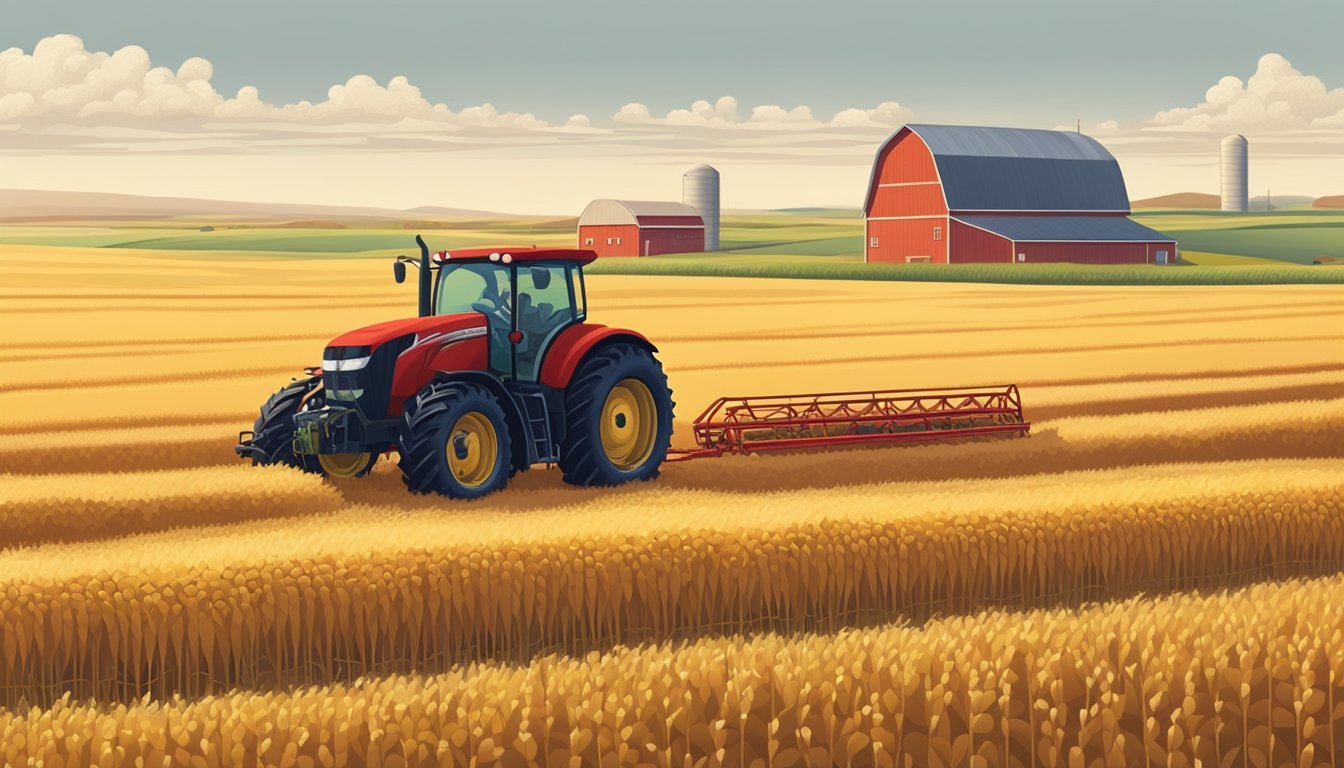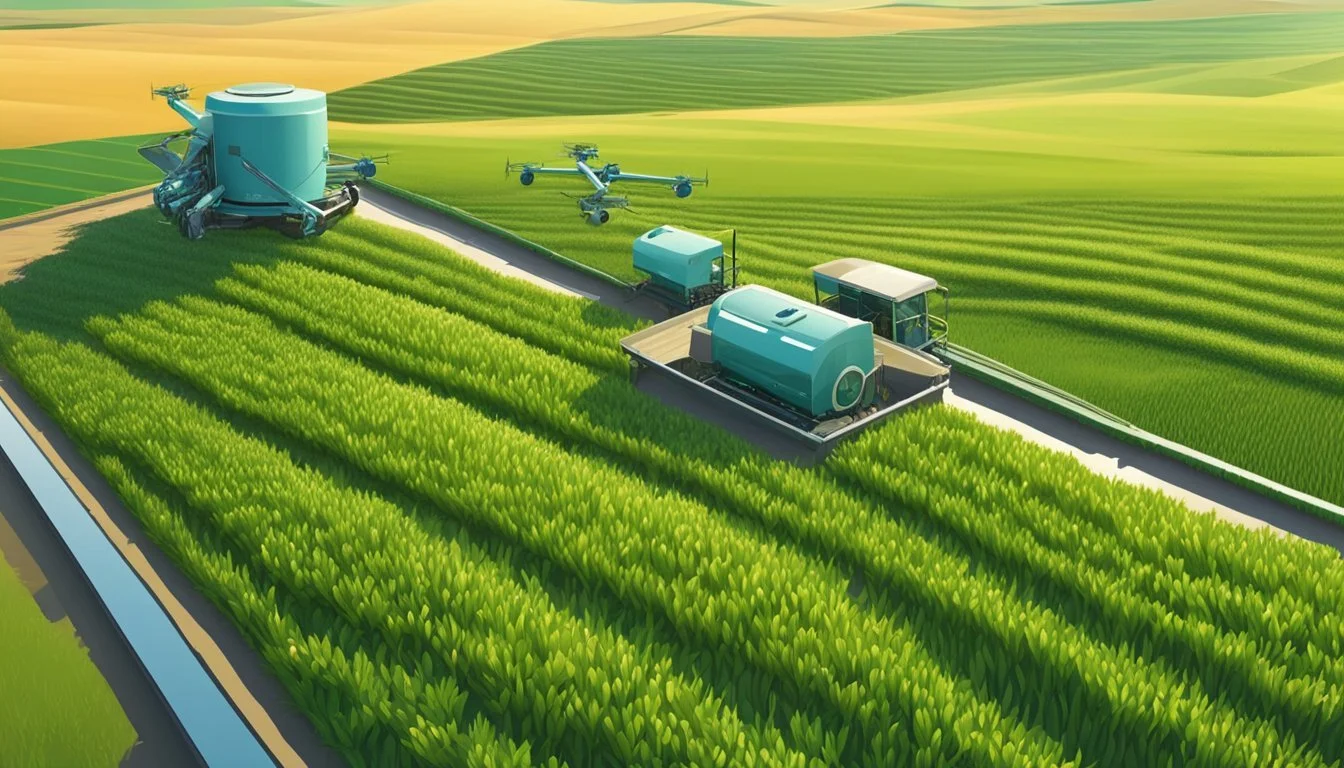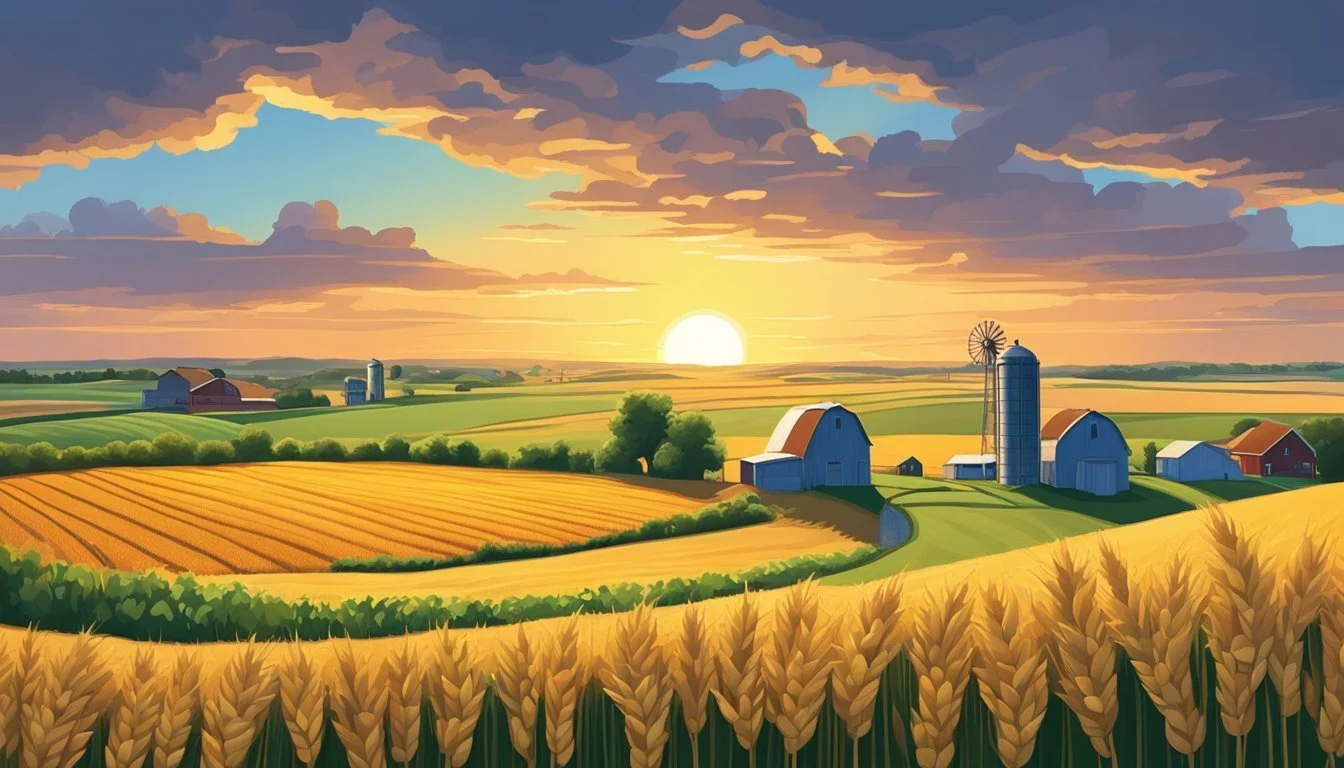Farming Communities in North Dakota
Growth, Challenges, and Sustainable Practices
North Dakota's farming communities are the lifeblood of the state's agriculture-driven economy. With nearly 6,000 acres of farmland currently available for sale, these communities continue to thrive on their rich agricultural traditions. The expansive farms and ranches contribute significantly to the local and national markets, offering products ranging from grains to livestock.
The culture within these farming communities is deeply rooted in family and tradition. Many of the farms have been passed down through generations, adding a layer of heritage to their operational practices. These communities also serve as vital economic hubs, providing jobs and supporting local businesses, thus playing a critical role in sustaining the region's economic health.
The sense of community is unparalleled, as neighbors frequently collaborate during planting and harvesting seasons. This cooperative spirit ensures that the agricultural practices remain efficient and innovative. The landscape of North Dakota, marked by its vast, productive lands, makes it an ideal location for farming and ranching, attracting both seasoned farmers and new investors alike.
History of North Dakota Farming
The development of farming in North Dakota has been shaped by settlers, the introduction of large-scale operations like Bonanza Farms, and significant advancements throughout the 20th century.
Settlement and Agriculture Development
Early settlers arrived in the Dakota Territory in the 1870s, driven by opportunities for land offered through the Homestead Act of 1862 and subsequent land policies. These pioneers transformed vast prairies into productive farmland. Railroads such as the Northern Pacific Railroad played a crucial role in this transformation by providing transportation for crops to larger markets.
Farm communities quickly formed, building schools, churches, and other infrastructure to support their growing populations. By 1890, North Dakota had over 27,000 farms, with wheat as a significant crop.
Rise of Bonanza Farms
A notable development in North Dakota's agricultural history was the emergence of Bonanza Farms. These were large-scale wheat farms that ranged from 3,000 to over 75,000 acres. They were established in the late 19th century and were notable for their size and productivity.
Oliver Dalrymple managed one of the most famous Bonanza Farms for the Northern Pacific Railroad. These farms employed hundreds of workers and utilized the latest farming techniques of the time. Their success played a pivotal role in establishing the region’s reputation for agricultural productivity.
20th Century Farming Evolution
Farming in North Dakota continued to evolve through the 20th century. Technological advancements such as mechanization and scientific improvements in crop management significantly increased efficiency and productivity. Tractors replaced horses, and methods for pest control and soil conservation improved.
Agribusiness became more prominent, with family farms adopting diverse crops and livestock operations. By 2019, the average farm size in North Dakota had grown significantly compared to earlier years, underscoring the trend toward larger, more efficient farming operations. This era marked the transition to modern agriculture, blending tradition with innovation to meet economic and environmental challenges.
Geography and Climate of Farming Regions
North Dakota's farming communities are shaped by distinct geographical features and climates. Understanding these factors is crucial for effective agricultural practices.
Red River Valley
The Red River Valley, located in the eastern part of North Dakota, features flat terrain with rich, fertile soil. This area is well-suited for growing crops like wheat, corn, and soybeans. The valley's topography allows for efficient irrigation and drainage, enhancing its suitability for farming.
The Red River borders this region, providing a natural irrigation source. Annual precipitation averages around 20-25 inches, with most rainfall occurring between May and September. This climate supports a longer growing season compared to other regions in the state.
Unique Soil Conditions
North Dakota's soil varies significantly across its regions, impacting farming methods and crop productivity. The Red River Valley boasts loamy soil, which is high in nutrients and retains moisture well. This contrasts sharply with the Missouri Plateau's rocky soil, which is less fertile and more challenging to cultivate.
In the Drift Prairie, small ponds and rolling hills create unique agricultural landscapes. The soil here often requires additional fertility management due to its mixed composition of clay and silt. Effective soil management strategies are essential to maximize crop yields.
Climate Impacts on Farming
Climate modeling indicates that North Dakota experiences harsh winters and warm summers, influencing agricultural cycles. Winter wheat and other hardy crops are common, as they can withstand the low temperatures. Conversely, the warm summers allow for the growth of heat-tolerant crops like sunflowers and corn.
Weather variability, including frost dates and precipitation levels, requires farmers to be adaptive and resourceful. Drought-resistant crop varieties and advanced irrigation techniques are increasingly used to mitigate the effects of unpredictable weather patterns on farming productivity.
Main Crops and Livestock
North Dakota's agriculture is diverse, with a strong focus on both crop production and livestock farming. The state's economy benefits significantly from wheat, barley, corn, soybean, and livestock industries.
Grains: Wheat and Barley
Wheat is a fundamental crop in North Dakota, with the state leading the nation in the production of durum wheat, essential for pasta. Hard red spring wheat is another key variety grown here, known for its high protein content.
Barley is also extensively cultivated, used primarily for malt in the brewing industry. North Dakota's climate and soil are ideal for these grains, making them crucial to the state's agricultural output.
Growth of Corn and Soybean Cultivation
Corn has seen substantial growth, particularly in the eastern regions. It is used for livestock feed, ethanol production, and various food products. Advancements in farming techniques and biotechnology have increased yields.
Soybeans, another vital crop, are grown extensively across the state. They are processed into oil and meal, contributing significantly to the agricultural economy. Canola and potatoes are also noteworthy, though less dominant, adding to the diversity of North Dakota's crop production.
Livestock Farming
Livestock farming is a major component of North Dakota's agricultural sector. Beef cattle dominate, with many farms dedicated to raising dairy cattle and sheep as well. These animals contribute to both meat and dairy industries.
Alfalfa is produced in large quantities as a primary livestock feed. The region's soil and climate conditions support high-quality feed production, ensuring healthy cattle. This balance of crop and livestock farming reflects the integrated nature of North Dakota's agriculture.
Technological Advancements in Agriculture
North Dakota's farming communities are at the forefront of embracing innovative technologies. From mechanization to sophisticated IT systems and cutting-edge biotechnology, these advancements are transforming traditional agricultural practices and leading to increased efficiency and sustainability.
From Manual Labor to Mechanization
Technological progress has shifted North Dakota agriculture from relying on manual labor to employing advanced machinery. Plows initially revolutionized soil preparation. Tractors and other mechanized equipment have further streamlined tasks such as planting and harvesting.
In modern farming, machinery equipped with precision agriculture technology ensures efficient use of resources, reducing labor costs and increasing yield. Autonomous machines and drones, driven by AI, represent the latest phase of this evolution, minimizing human intervention.
Information Technology in Farming
The integration of Information Technology (IT) in North Dakota agriculture has enhanced data-driven decision-making. Farmers use nanoscale sensors and computer networks to monitor soil health, moisture levels, and crop conditions in real-time.
The North Dakota Advanced Agriculture Technology Engine exemplifies the state's commitment to leveraging IT for improved agricultural practices. These advanced systems optimize resource utilization, reduce waste, and boost crop productivity.
Biotechnology and Genomics
Biotechnology and genomics are transforming crop cultivation in North Dakota. By applying advanced genomics, researchers are developing crop varieties that are more resistant to diseases and climate variations. This enhances crop yield and reduces dependency on chemical pesticides.
The North Dakota Advanced Agriculture Technology Engine is a key player in this field, combining genomics with climate modeling and other technologies to create resilient crops. Collaboration with entities like universities and agricultural companies accelerates innovations in this area.
Socio-Economic Aspects of Farming
Farming communities in North Dakota are greatly influenced by both family-owned farms and large-scale corporate agriculture. Additionally, the evolution of the labor market and the economic contributions of the agricultural sector profoundly shape the region.
Family Farms vs. Corporate Agriculture
Family farms play a crucial role in North Dakota's agricultural landscape. They are often handed down through generations, sustaining family livelihoods and fostering local communities. In contrast, Bonanza Farms, large-scale operations historically backed by investors, have a strong presence, driven by efficient production goals.
While family farms emphasize sustainable practices and local employment, corporate agriculture focuses on maximizing output, often using advanced technologies. This contrast shapes the state's economic and social fabric, balancing tradition with modern farming techniques.
Labor Market and Workforce Development
The labor market in North Dakota's farming sector is diverse, comprising seasonal workers, family members, and specialized labor. Workforce development programs aim to equip workers with skills in modern agricultural techniques and technologies, essential for meeting the demands of contemporary farming.
Population dynamics in farming areas are influenced by job availability. Farmers and agricultural investors invest in training initiatives, from on-the-job training to partnerships with local educational institutions. These efforts are crucial to ensure that the farming workforce remains skilled and adaptable.
Economic Contribution to North Dakota
Agriculture remains a cornerstone of North Dakota's economy. Family farms and corporate agriculture alike contribute significantly to the state's GDP. Both types of farms support a wide range of jobs, from farming to processing and distribution, thus fostering economic growth.
Economic activities related to farming generate income not only for farmers but also for local businesses. As agricultural products move through the supply chain, they create economic opportunities across various sectors. This interconnectedness underlines the importance of agriculture in maintaining the state's economic health.
Agricultural Education and Research
Agricultural education and research play crucial roles in supporting and advancing farming communities in North Dakota. Institutions like North Dakota State University (NDSU) are at the forefront of these efforts, driving innovation and partnerships to tackle agricultural challenges.
Role of Research Institutions
Research institutions are essential in developing new agricultural technologies and practices. They conduct studies that lead to advances in crop resilience, pest management, and sustainable farming techniques. By collaborating with local farmers, these institutions ensure that their research addresses real-world issues.
In North Dakota, research institutions contribute to the agricultural sector by providing training and resources. They help farmers adopt modern methods that increase productivity and environmental sustainability. Funding and grants further enable these institutions to explore innovative solutions and enhance the state's agricultural output.
North Dakota State University's Contributions
North Dakota State University (NDSU) is a key player in agricultural education and research. As a land-grant university, NDSU focuses on student education, public outreach, and research. The university's agriculture programs equip students with vital knowledge in food systems and natural resources.
NDSU's research initiatives address pressing agricultural problems. These include developing cost-effective solutions and fostering community partnerships. The university’s efforts in fundamental and applied research help shape policies and practices that benefit local farmers. Additionally, NDSU's Extension services share research findings with the public, ensuring that the latest innovations reach the farming community.
Environmental Sustainability and Agriculture
In North Dakota, farming communities have embraced a variety of practices to enhance environmental sustainability and land use efficiency. Initiatives focus on maintaining soil health and reducing emissions, ensuring that agriculture remains productive and resilient.
Conservation Practices
Crop Rotation: Farmers use crop rotation to improve soil fertility and break pest cycles. This involves alternating the types of crops grown on a piece of land yearly.
Cover Crops: Planting cover crops like clover or rye helps prevent soil erosion, add organic matter, and enhance nutrient content.
No-Till Farming: By minimizing soil disturbance, no-till farming helps conserve fuel and protect the environment. It also maintains soil structure and reduces erosion.
Carbon Farming: Techniques such as reduced tillage and organic farming practices help sequester carbon in the soil. This captures carbon emissions and boosts soil health, creating a more sustainable agricultural system.
Challenges and Adaptation Strategies
Extreme Weather: North Dakota's farming communities face challenges from extreme weather events. To adapt, they incorporate weather-resilient crop varieties and rotations into their farming strategies.
Water Management: Efficient water use is crucial in semi-arid conditions. Drip irrigation and water-efficient crops help in conserving water resources and sustaining agriculture.
Economic Viability: Ensuring that sustainable practices are economically viable can be challenging. Grants and subsidies from institutions like the EPA support farmers in implementing eco-friendly practices.
Education and Outreach: Organizations like FARRMS provide resources and training to support sustainable farming practices. These efforts help farmers adopt and maintain conservation techniques that benefit both the environment and their livelihoods.
By integrating these practices and strategies, North Dakota farmers contribute significantly to both environmental sustainability and agricultural productivity.
Cultural Impact of Farming in North Dakota
Farming has deeply shaped the culture and society of North Dakota. The traditions and customs in rural communities reflect a strong respect for the agricultural way of life.
Traditions and Community
Farming traditions in North Dakota are often passed down through generations, creating a strong sense of heritage in rural communities. Families usually work together on their farms, fostering cooperation and mutual support. These practices emphasize not only agricultural skills but also life values such as hard work, dedication, and respect for nature.
Community gatherings often center around farming activities. Events like barn raisings and harvest festivals provide opportunities for socialization and reinforce community bonds. These gatherings also serve as a platform for sharing knowledge and celebrating collective achievements.
Agricultural Celebrations and Events
Agricultural celebrations in North Dakota are significant community events. County fairs, often held in the summer, showcase livestock, crops, and homemade goods. They serve as a venue for farmers to exhibit their hard work and innovations, reinforcing community pride.
Other events include harvest festivals and farmers' markets. These festivals celebrate the end of the growing season with activities like parades, food tastings, and craft stalls. Farmers' markets, operating weekly, allow direct interaction between producers and consumers, fostering a sense of community and providing fresh, local produce.
These celebrations not only highlight agricultural successes but also strengthen the cultural fabric of North Dakota.
The Future of Farming in North Dakota
North Dakota is charting new territory in agricultural innovation. Advances include the adoption of emerging crops and responses to global market trends, promising higher productivity and diverse opportunities for family farms.
Emerging Crops and Diversification
North Dakota's farmers are increasingly exploring emerging crops to diversify their production and increase profit margins. These crops, which include industrial hemp and specialty grains, offer promising growth potential. Their adaptation to North Dakota’s climate and soil conditions is intensively researched at institutions like North Dakota State University.
Innovation drives these efforts, with advanced agricultural technologies optimizing crop yields and resilience. Family farms benefit by rotating emerging crops with traditional staples like wheat and soybeans, enhancing soil health and reducing dependency on a single crop market. This not only improves profit margins but also ensures sustainable farming.
Size and scale are essential factors. Small to mid-sized farms see increased productivity as they integrate these new crops. Collaborative programs and state-supported initiatives provide resources and knowledge to facilitate this transition. The focus remains on practical, achievable steps that promise significant returns.
Impact of Global Market Trends
Global market trends significantly influence North Dakota's agriculture sector. Farmers and agricultural leaders pay close attention to shifts in demand and prices on the international stage. Trade policies, climate change, and geopolitical dynamics shape these trends. Market accessibility is crucial; stable international relationships ensure North Dakota's produce reaches a wide audience.
Growth in demand for organic and non-GMO crops offers North Dakota farmers lucrative new markets. Family farms are particularly well-positioned to capitalize on these preferences due to their adaptable size and practices. This has spurred an increase in the cultivation of such crops, further diversifying agricultural output.
Innovation in supply chain logistics ensures North Dakota's exports remain competitive. Efficient transportation networks and storage solutions maintain high-quality produce. As technological advancements continue, they will enhance productivity and reduce costs, solidifying North Dakota’s standing in the global agricultural market.








